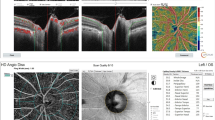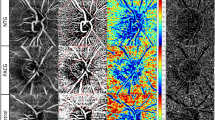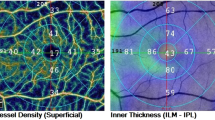Abstract
Purpose
Juvenile open angle glaucoma (JOAG) is a type of glaucoma that occurs in patients younger than 40 years. Only a few studies have assessed vascular perfusion in JOAG and correlated it with structural damage. The aim of this study is to investigate vascular perfusion in JOAG by optical coherence tomography angiography (OCTA) and correlate it with structural damage, represented by retinal nerve fiber layer (RNFL) thinning.
Methods
This is a cross-sectional observational study of 25 eyes of patients with JOAG. All patients underwent full ocular examination and scanning by OCTA to measure parameters such as RNFL thickness, peripapillary and disk vascular density.
Results
Average superior and inferior RNFL thicknesses were 69.4 (± 22.1) and 70.4 (± 25.6) μm, whereas peripapillary and disk vascular densities were 38.2(± 10), and 39.1(± 12) % and superior and inferior vascular densities were 38.1(± 10.5) and 38.2(± 9.7) %. A strong positive correlation was found between the superior and inferior RNFL thickness and the vascular density of the peripapillary region, the disk and the superior and inferior vascular densities (p < 0.001 for all).
Conclusion
OCTA parameters are strongly correlated with structural damage in JOAG patients. OCTA can serve as a helpful tool in the diagnosis and assessment of progression in JOAG and be utilized as a prognostic indicator, thus filling the defects and gaps present in other methods of assessment.



Similar content being viewed by others
References
Marx-Gross S, Laubert-Reh D, Schneider A et al (2017) The prevalence of glaucoma in young people. Dtsch Arztebl Int 114(12):204–210
Wan KH, Leung CK (2017) Optical coherence tomography angiography in glaucoma: a mini-review. F1000Research 6:1686. https://doi.org/10.12688/f1000research.11691.1 (F1000 Facult y Rev)
Yarmohammadi A, Zangwill LM, Diniz-Filho A, Suh MH, Manalastas PI, Fatehee N, Yousefi S, Belghith A, Saunders LJ, Medeiros FA, Huang D, Weinreb RN (2016) Optical coherence tomography angiography vessel density in healthy, glaucoma suspect, and glaucoma eyes. Invest Ophthalmol Vis Sci 57:451–459
Geyman LS, Garg RA, Suwan Y, Trivedi V, Krawitz BD, Mo S, Pinhas A, Tantraworasin A, Chui TYP, Ritch R, Rosen RB (2017) Peripapillary perfused capillary density in primary open-angle glaucoma across disease stage: an optical coherence tomography angiography study. Br J Ophthalmol 101:1261–1268
Rao HL, Kadambi SV, Weinreb RN, Puttaiah NK, Pradhan ZS, Rao DAS, Kumar RS, Webers CAB, Shetty R (2017) Diagnostic ability of peripapillary vessel density measurements of optical coherence tomography angiography in primary open-angle and angle-closure glaucoma. Br J Ophthalmol 101:1066–1070
Triolo G, Rabiolo A, Shemonski ND, Fard A, Di Matteo F, Sacconi R, Bettin P, Magazzeni S, Querques G, Vazquez LE, Barboni P, Bandello F (2017) Optical coherence tomography angiography macular and peripapillary vessel perfusion density in healthy subjects, glaucoma suspects, and glaucoma patients. Invest Ophthalmol Vis Sci 58(13):5713–5722
Sehi M, Greenfield DS (2006) Assessment of retinal nerve fiber layer using optical coherence tomography and scanning laser polarimetry in progressive glaucomatous optic neuropathy. Am J Ophthalmol 142(6):1056–1059
Mrugacz M, Bakunowicz-Lazarczyk A (2005) Optical coherence tomography measurement of the retinal nerve fiber layer in normal and juvenile glaucomatous eyes. Ophthalmologica 219(2):80–85
Gupta V, Ov M, Rao A, Sharma A, Sihota R (2012) Long-term structural and functional outcomes of therapy in juvenile-onset primary open-angle glaucoma: a five-year follow-up. Ophthalmologica 228(1):19–25
Ko YC, Liu CJ, Chou JC, Chen MR, Hsu WM, Liu JH (2002) Comparisons of risk factors and visual field changes between juvenile-onset and late-onset primary open-angle glaucoma. Ophthalmologica 216(1):27–32
Johnson AT, Drack AV, Kwitek AE et al (1993) Clinical features and linkage analysis of a family with autosomal dominant juvenile glaucoma. Ophthalmology 100:524–529
Wiggs JL, Haines JL, Paglinauan C et al (1994) Genetic linkage of autosomal dominant juvenile glaucoma to 1q21-q31 in three affected pedigrees. Genomics 21:299–303
Aponte EP, Diehl N, Mohney BG (2010) Incidence and clinical characteristics of childhood glaucoma: a population-based study. Arch Ophthalmol 128:478–482
Yanagi M, Kawasaki R, Wang JJ, Wong TY, Franzco JC, Kiuchi Y (2011) Vascular risk factors in glaucoma: a review. Clin and Exp Ophthalmol 39:252–258
Park SC, Kee C (2007) Large diurnal variation of intraocular pressure despite maximal medical treatment in juvenile open angle glaucoma. J Glaucoma 16:164–168
Wang X, Jiang C, Ko T et al (2015) Correlation between optic disc perfusion and glaucomatous severity in patients with open-angle glaucoma: an optical coherence tomography angiography study. Graefes Arch Clin Exp Ophthalmol 253(9):1557–1564
Akil H, Huang AS, Francis BA, Sadda SR, Chopra V (2017) Retinal vessel density from optical coherence tomography angiography to differentiate early glaucoma, pre-perimetric glaucoma and normal eyes. PLoS ONE 12(2):e0170476
Yoshikawa Y, Shoji T, Kanno J, Kimura I, Hangai M, Shinoda K (2018) Optic disc vessel density in nonglaucomatous and glaucomatous eyes: an enhanced-depth imaging optical coherence tomography angiography study. Clin Ophthalmol 12:1113–1119
Shin JW, Lee J, Kwon J, Choi J, Kook MS (2017) Regional vascular density-visual field sensitivity relationship in glaucoma according to disease severity. Br J Ophthalmol 101:1666–1672
Mansoori T, Sivaswamy J, Gamalapati JS, Balakrishna N (2017) Radial peripapillary capillary density measurement using optical coherence tomography angiography in early glaucoma. J Glaucoma 26:438–443
Yarmohammadi A, Zangwill LM, Diniz-Filho A, Saunders LJ, Suh MH, Wu Z, Manalastas PIC, Akagi T, Medeiros FA, Weinreb RN (2017) Peripapillary and macular vessel density in glaucoma patients with single-hemifield visual field defect. Ophthalmol 124(5):709–719
Park JH, Yoo C, Kim YY (2019) Peripapillary vessel density in young patients with open-angle glaucoma: comparison between high-tension and normal-tension glaucoma. Sci Rep 9(1):19160. https://doi.org/10.1038/s41598-019-55707-5
Kwun Y, Lee EJ, Han JC, Kee C (2016) Clinical characteristics of juvenile-onset open angle glaucoma. Korean J Ophthalmol 30(2):127–133
Yarmohammadi A, Zangwill LM, Diniz-Filho A, Suh MH, Yousefi S, Saunders LJ et al (2016) Relationship between optical coherence tomography angiography vessel density and severity of visual field loss in glaucoma. Ophthalmol 123:2498–2508
Yarmohammadi A, Zangwill LM, Diniz-Filho A, Suh MH, Manalastas PIC, Fatehee N et al (2016) OCT angiography vessel density in normal, glaucoma suspects and glaucoma eyes: structural and functional associations in the diagnostic innovations in glaucoma study (DIGS). Invest Ophthalmol Vis Sci 57:2958
Hollo G (2016) Vessel density calculated from OCT angiography in 3 peripapillary sectors in normal, ocular hypertensive, and glaucoma eyes. Eur J Ophthalmol 26(3):e42–e45
Hollo G (2019) Peripapillary capillary vessel density progression in advanced glaucoma: a case report. BMC Ophthalmol 19:2
Acknowledgements
The authors alone are responsible for the content and writing of the paper.
Funding
None.
Author information
Authors and Affiliations
Corresponding author
Ethics declarations
Conflict of interest
The authors declare that they have no conflict of interest.
Additional information
Publisher's Note
Springer Nature remains neutral with regard to jurisdictional claims in published maps and institutional affiliations.
Rights and permissions
About this article
Cite this article
Abdelrahman, A.M., Eltanamly, R.M., Elsanabary, Z. et al. Optical coherence tomography angiography in juvenile open angle glaucoma: correlation between structure and perfusion. Int Ophthalmol 41, 883–889 (2021). https://doi.org/10.1007/s10792-020-01643-7
Received:
Accepted:
Published:
Issue Date:
DOI: https://doi.org/10.1007/s10792-020-01643-7




